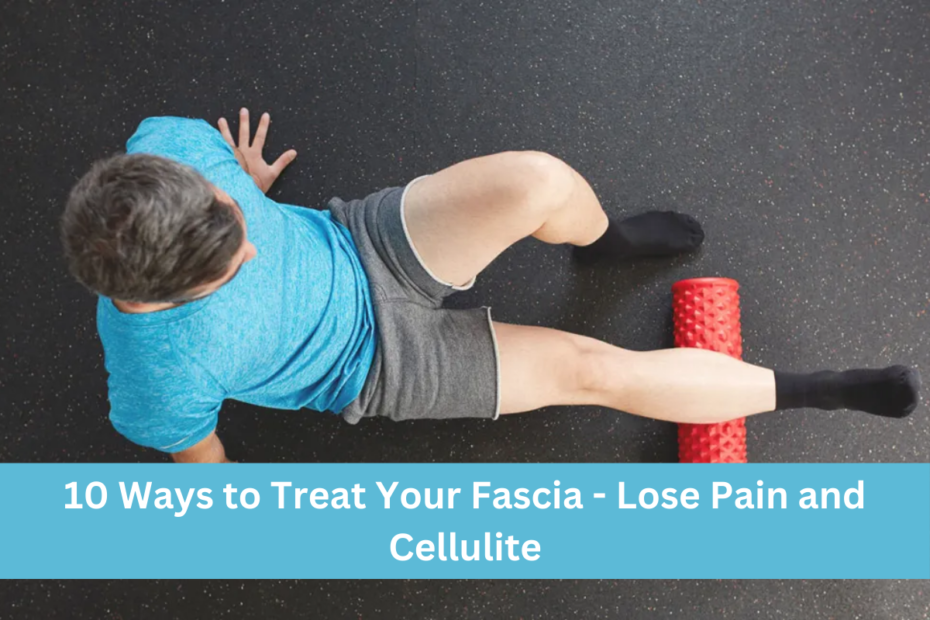10 Ways to Treat Your Fascia – Lose Pain and Cellulite:- One of the most important components of your body’s structure and function is the connective tissue known as fascia, which surrounds and protects your muscles, bones, and organs.
10 Ways to Treat Your Fascia – Lose Pain and Cellulite
It is possible for individuals to have pain, restricted movement, and even the appearance of cellulite as a result of fascia that has become tight or restricted.
Fascia treatment can facilitate the healing process, increase movement, and contribute to an overall improvement in well-being. The following is a list of ten effective strategies to care for your fascia, with the goal of minimizing cellulite and alleviating pain.
1. Foam Rolling

Self-myofascial release, often known as foam rolling, is a common practice that targets certain parts of the fascia that are tight. Through the application of pressure to particular areas on the body, this technique assists in the release of tension and enhances blood circulation.
ALSO SEE : 10+ Benfits of Jackfruit for your Health
This makes foam rolling a good method for managing discomfort and promoting relaxation in the fascia. Regular foam rolling sessions can improve flexibility and mobility, making it a useful tool.
2. Myofascial Release Therapy

The goal of myofascial release therapy is to alleviate tension in the fascia with the use of hands-on procedures that are performed by qualified therapists. The application of gentle, continuous pressure is the primary emphasis of this therapy.
Which aims to promote relaxation and restore the natural function of the connective tissue during the treatment of restricted areas. The individuals who are suffering from chronic pain or who have a restricted range of motion may benefit from it in particular.
3. Hydration

When it comes to keeping healthy fascia, proper hydration is absolutely necessary. Maintaining an adequate level of hydration is essential for maintaining the flexibility and proper functioning of fascia, which is primarily made of water.
It is possible for dehydration to cause stiffness and limitations, which can make the discomfort much worse. Consuming an adequate amount of water throughout the day can be beneficial to the health of your fascia as well as the functional capabilities of your body as a whole.
4. Stretching

When it comes to maintaining the fascia’s flexibility, stretching on a consistent basis is an imperative requirement. Stretching has a number of therapeutic effects, including the stimulation of the fascia to relax and the enhancement of blood flow when performed.
The health of the fascia can be considerably improved by performing static stretches after exercises as well as dynamic stretches before participation in those activities. In addition to improving flexibility, this technique also helps to reduce the risk of incurring injuries.
5. Regular Exercise

Participating in physical activity is absolutely necessary in order to maintain healthy fascia. The flexibility of connective tissues can be maintained and improved by exercise, which also aids enhance circulation.
Strength training, yoga, and Pilates are all excellent examples of activities that are particularly useful since they work to improve the health of both the muscles and the fascia. To enhance overall mobility and to minimize discomfort, a well-balanced exercise plan can be beneficial.
6. Massage Therapy

In order to effectively relieve tension in the fascia and the muscles that surround it, massage treatment is an efficient method. There are a variety of treatments that help enhance blood flow, alleviate tension, and promote relaxation.
Some of these techniques include deep tissue massage and sports massage. Receiving massages on a regular basis can assist in the management of pain, improve the healing process, and contribute to overall well-being.
7. Heat Therapy

The application of heat to the body has the potential to increase circulation and relax fascia that is tight. The application of heat treatment can be accomplished by the use of techniques such as hot baths, heating pads, or heated towels.
This method not only reduces the sensation of pain, but it also gets the fascia ready for stretching or other forms of physical activity, which makes it an efficient use for relaxation.
8. Cold Therapy

It is possible that cold therapy will be helpful in lowering inflammation and numbing discomfort in the areas that are problematic. In order to alleviate acute pain and swelling, techniques such as applying cold compresses or ice packs can be utilized.
These techniques provide relief for injuries or soreness. The use of cold therapy as a supplemental strategy to heat therapy can be beneficial in reducing both inflammation and pain conditions.
9. Nutrition

Your diet is a crucial factor in determining the health of your fascia. Fruits, vegetables, nuts, seeds, and fatty fish are all examples of foods that include anti-inflammatory properties, and eating a range of these foods can help maintain healthy connective tissue function.
There are certain nutrients, such as omega-3 fatty acids, that are very advantageous, as they contribute to the overall health of the body and the fascia. In addition to helping to alleviate discomfort, a diet that is well-balanced can also help reduce the appearance of cellulite.
10. Mind-Body Techniques

Relaxation and increased bodily awareness are two benefits that can be gained from engaging in mind-body practices such as yoga, tai chi, and meditation. You will be able to alleviate tension and improve the body’s response to stress by practicing these techniques.
Which encourage deep breathing and mindfulness among its practitioners. Through participation in these techniques, one can achieve increased fascia health and a heightened sense of well-being, which can assist in the reduction of pain and the improvement of one’s quality of life in general.
